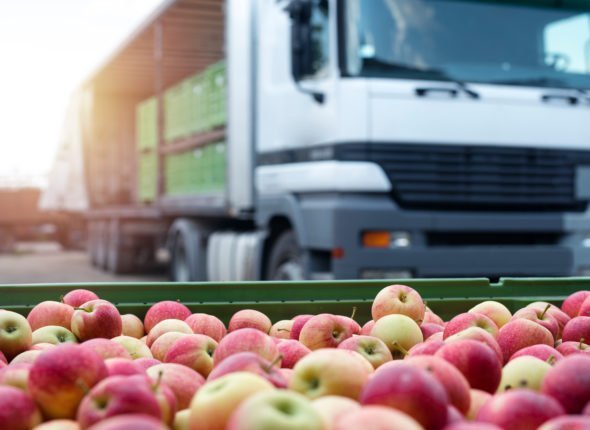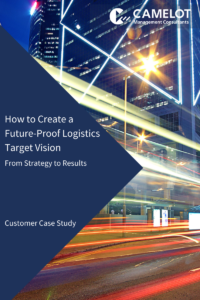Visibility in today’s logistics is an issue on the agenda of every supply chain manager. The awareness of the importance and future relevance of the subject is given, but in reality the approach still turns out to be a complex project. As part of our supply chain visibility blog post series, the following use case is intended to illustrate a practical approach and specificity of supply chain visibility with the value it brings to the daily business.
Supply Chain Visibility as service in the food industry
Supply Chain Visibility provides consumers and retailers an insight into the origin, the supply chain path and the condition of their products. Industry standards in the food industry already enforce product visibility about information on freshness and conditions. However, changing business requirements and business models driven by an increased consumer awareness for sustainability and ecology in the food sector demand a new level of visibility.
Logistics supporting the fight against food waste
Did you know what happens to 30% of high-quality food in the fruit and vegetable harvest? They fall through the grid of trade chains and large supermarket chains only because of optical flaws. Though this food complies to all quality requirements, it is sorted out or processed as lower-valued animal feed. The food industry thus puts optical requirements equal to the quality requirements of food.
Supermarkets, like our fictive use case example NoWasteMarket, oppose this type of food waste, meeting the desire of many consumers for sustainability. NoWasteMarket obtains parts of the discarded fruit and vegetable harvest from regional growers and sells them in their supermarkets. In doing so, they are particularly appealing to customers who consciously opt for a sustainable use of food not having to compromise on quality. The concept of less food waste in combination with fresh and high-quality products addresses existing customers as well as inspires new customers for this policy.
NoWasteMarket states that the food industry manipulates the impression of the natural optic of fruits and vegetables. In dedicated jobs – so-called food designers – food is prepared with the help of artificial materials such as glue and hairspray to make it look especially appealing and palatable. However, this has little to do with the natural appearance of fruit and vegetables. NoWasteMarket is therefore concerned that small blemishes in the food might alienate customers. As a customer-oriented company, NoWasteMarket now wants to give its customers visibility into the supply chain of its goods. Visibility as extra service shall thereby affirm the consumers of the freshness and quality of their products. They can thus prove the consumer that a flawed look is not necessarily an indication of poor quality.
Visibility at the push of a button
NoWasteMarket obtains fruit and vegetables in a deposit system of wooden boxes from their regional suppliers. The boxes are equipped with calibrated temperature-measuring sensors. Many fruits and vegetables need to be transported and stored in a cool supply chain to prolong their freshness. In addition, information about the time and place of loading is added to the sensors. The sensors can be read out by scanners which are available to the customers at NoWasteMarket. When scanning the desired products at NoWasteMarket, customers learn the time and place of loading and whether the products were in an uninterrupted cold chain. Customers thereby gain the control to decide upon facts and information whether the product is still fresh enough for them. They can also estimate how long further the product will be fresh and consumable despite its optical flaws. Once the products of a packaging box are sold, the data on the sensor can be deleted and the box is returned to the supplier, who can activate the sensor again after the new filling.
Visibility creates confidence
The fictive company NoWasteMarket pioneers the concept of visibility for end user as link between sustainability and freshness. The concept away from the disposable culture of today’s supermarkets is already rolled out in other sectors, as for example REWE Group is offering in several markets with its proper name Wunderlinge. But until now only isolated approaches for different types of food are available.
Visibility and information let customers identify with the company and its products. NoWasteMarket thus accomplishes to gain the trust of its customers. Especially in times of increased food scandals, trust is a cornerstone for the long-term bonding of customers. NoWasteMarket takes advantage of discounted purchase prices in procurement. Due to the resulting win-win-win situation between suppliers, NoWasteMarket and the end customer, the project could easily be implemented with evenly distributed investments. As a next step, NoWasteMarket already considers extending their visibility service to other products like milk products. The importance and demand for visibility is a general trend in the food industry and can be observed in several specifies. Visibility service providers like Followfood already advertise transparency of fish, vegetable and wine from the origin and food producers like Arla offer transparency to their customers in form of blockchain for their milk products. The rising demand for transparency from customers and consumers will lead to a more holistic and smart visibility solution as condition for the success in the customer-oriented food and retail industry.
At this point we would like to highlight again, that our example company NoWasteMarket is fictive to protect confidential client information but it is based on real companies.
Supply chain visibility, as in this case, supports and establishes new business models. Even small steps into visibility allow traders to increase control over their supply chain. In industries with proximity to customers or sensitive and perishable goods, SCV is no longer a nice-to-have, but a more indispensable added value.


